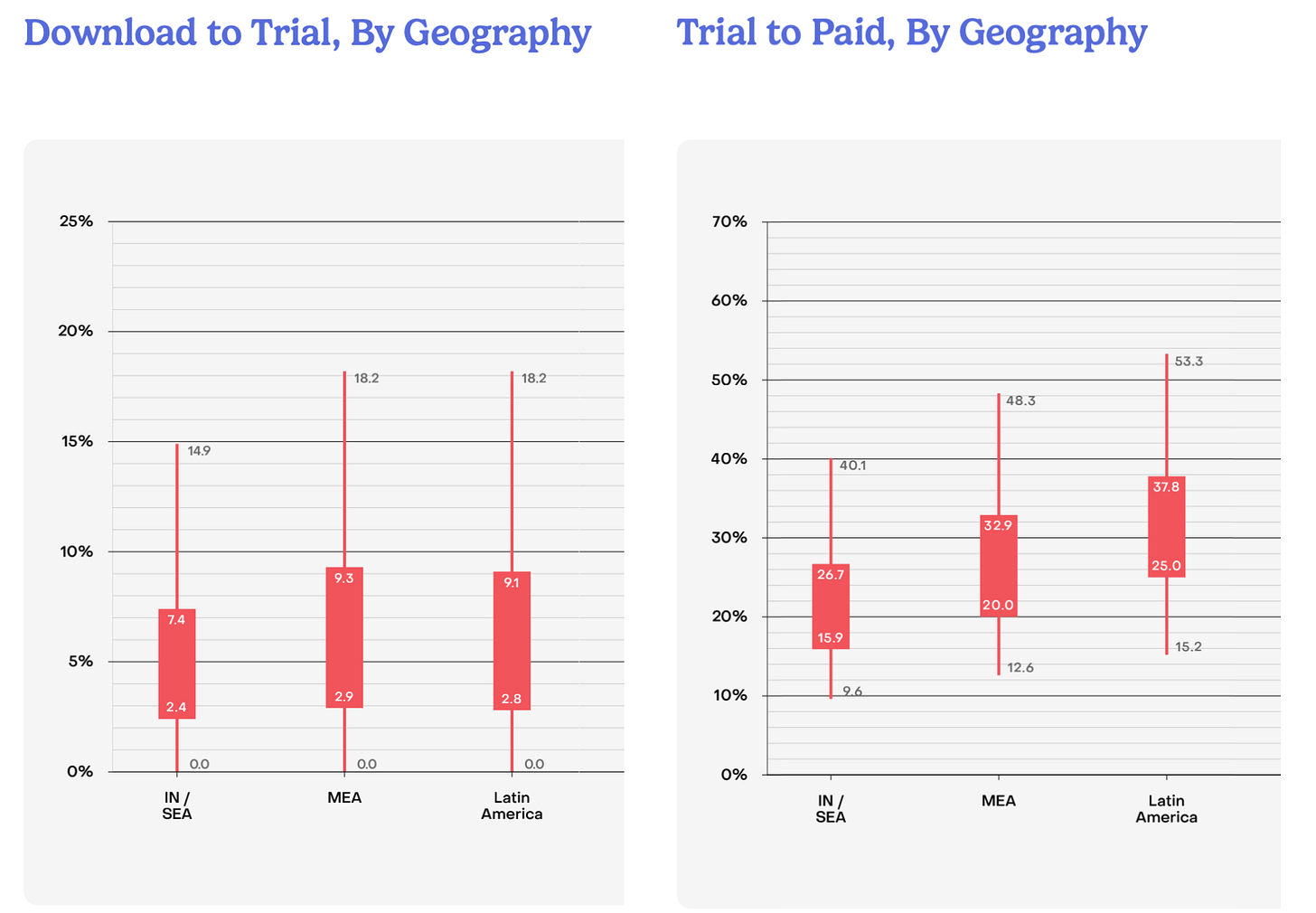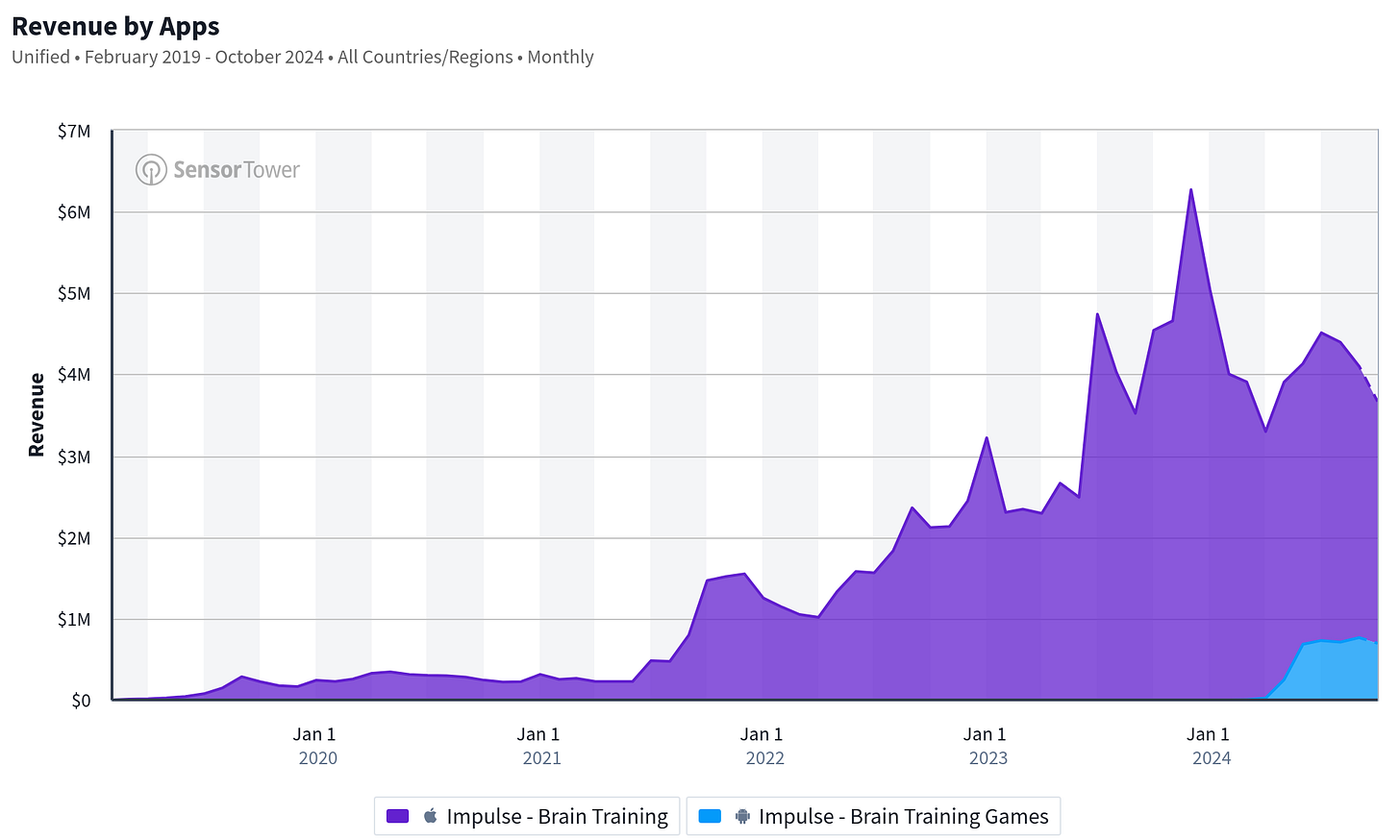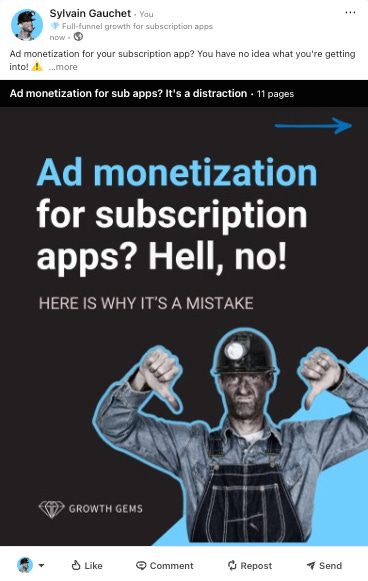💎 Should you also monetize your subscription app with ads?
The pros and cons of discounts and a decision matrix to know if you should prioritize this.
Monetizing with subscriptions means you miss out on generating revenue from a lot of users.
One way of changing this is monetizing with ads, which can make a “free” user base much more valuable (and worth it).
But it’s not that simple, so let’s look at pros and cons.
Now, before we dive in, here’s how this post is laid out:
🤝 FRIENDS OF GROWTH GEMS
Tired of commenting on LinkedIn posts to “get 300 onboarding screenshots”? 😂
More seriously, I’ve tried a few different “onboarding & paywall” tools the last few years. They usually fall short.
Here’s what I love about screensdesign:
They include video recordings (some interactions are key!)
You can filter by installs, revenue, or revenue per install (to find the ones that monetize the best - you’re welcome)
And guess what? I also got you a sweet offer :)
Hell, yes!
Some geos are just not big on subscriptions (particularly on Android)
You’re adding a lever to convert to a subscription (or IAPs!)
Before we start, in case you’re not familiar with what eCPM means:
If you look at CPMs for your advertising campaigns, well, this is the other side of the coin.
1. The opportunity is too big to ignore
Subscriptions have a “high floor” to begin with, and 90%+ of downloads never translate into any dollars, even with a solid and elaborate discount strategy.
Most users who convert do so right away or within a few hours. What about all the other ones? That’s about 93-95% of users you’re not monetizing.
RevenueCat’s State of Subscription Apps 2025 data shows how big the opportunity is depending on your category (particularly on Android).
Monetizing with ads means you capture value from different user segments with varying willingness to pay. No one is “riding for free”. #F***Freeloaders.
It seems you can hope for about 10-30% additional revenue.


There is also strong signal from the gaming world that this also translates to ROAS. In The State of App Monetization – 2024 Edition, AppsFlyer reports:
Android Mid-core games hit 146% ROAS by Day 90 with hybrid monetization, vs. 93% for In-App Purchases (IAP) and 58% for In-App Ads (IAA).
iOS Mid-core games hit 90% ROAS by Day 90 with hybrid monetization, vs 45% for IAP and 54% for IAA.
There are many differences between game and non-game apps, but this does show the power of hybrid monetization…And even big brands like Netflix understood this.
2. Some geos are just not big on subscriptions (particularly on Android)
Your iOS conversion to paid might look great in the US/Europe (although is it ever enough?), but what about in geos like Brazil, Turkey, or India?
Look at the median download to trial rate (lower edge of the box). These numbers are iOS and Android combined. Imagine if it was just Android.
Monetizing with ads means you can finally translate the userbase in these low-converting geos to dollars.
3. You can build an engaged free userbase
Once you’re monetizing non-subscribers, investing effort into a more “complete” experience that forms a habit and keeps them coming back makes sense. Goodbye, sub-par freemium experience!
All of a sudden, the engagement of your entire user base - not just the paying minority - directly impacts your bottom line.
You end up on the freemium side of the freemium <> premium spectrum, have more touch points with users, and set yourself up for faster scaling.
4. You’re adding a lever to convert to a subscription (or IAPs!)
Ads don’t only bring ad dollars.
With a few clever tactics (related to the annoyance of ads), ads can improve subscription conversion!
💎 Ad watchers are more engaged with the product (more active days, more sessions), are exposed to the premium features, and have more chances to convert later on.
(12:31) by Sandra Amir (Unity) in Play and learn: What apps can learn from games across the full growth funnel
The gem below is quite heavy, but worth fully understanding.
💎 Customize your ad monetization strategy based on how many days users have been using the app without paying.
D0-D1: players don’t see any interstitial ads during the initial “training program”, and they are encouraged to play games (sometimes paywalled) or take a test/quiz (w/ the results/reports paywalled) after completing the training program (no interstitial ads).
After D2: players are shown some interstitial ads during the game.
When closing the first interstitial ad, a pop-up is shown explaining how to skip interstitial ads.
When closing the second interstitial ad, a pop-up is shown explaining that you can play without ads by becoming a premium user with a free trial
When closing the third interstitial ad, an “overlay” nudge is shown, telling you where you can tap at all times to play without ads/start the trial (on the “Remove all ads” value prop).
After this, the more you use the app without paying, the more interstitial ads you show players
(19:15) by Felix Braberg in Impulse Brain Training games: A hyper scaling app masquerading as a brain training
It’s a very clever way to capture the higher intent people by converting them to a subscription (= Plan A), then leverage ads to increase conversion to subscription (= Plan B), and still monetize the ones that never convert through ads (= Plan C).
Below you can see that they show the paywall on app open, then an ad (that you wouldn’t see on your first day) once I start a game from my “personalized workout”.
From that same Impulse analysis:
💎 Put an X button at all times on your ad banners. When users tap on them, display the “no-ads” paywall.
(24:05) by Felix Braberg in Impulse Brain Training games: A hyper scaling app masquerading as a brain training
5. Give a “taste” of your subscription
Not all ad implementations are created equal, and rewarded video ads stand apart as a format that can genuinely enhance the user experience rather than detract from it (unlike interstitial or banner ads).
The value exchange is clear: users opt-in to view an advertisement in exchange for in-app rewards, premium features, or extended functionality.
💎 To get ad impressions for a subscription app, you can “give up” part of your subscription app content or give users a “taste” of what the subscription would be like via rewarded videos. Rewarded videos are the best way to monetize your users through ads: they have the highest eCPM and bring the least risk for retention.
(42:53) by Felix Braberg in MAU live 2023 - Growths Gems, Creative testing processes, UA for apps vs games!
I actually couldn’t find an example of this. If you know of one, please reply!
6. Tap into additional inventory through UA
Your current acquisition efforts already bring users that you would monetize through ads, improving unit economics.
But that’s not all.
We now have AdROAS campaigns on both Meta (Android) and Google.
This gives you a new acquisition lever to drive traffic to your app: you target users who will bring revenue through ads.
💎 If your game is monetized by ads, reach out to your Google representative to get guidelines about AdROAS campaigns. They were initially made for AdMob only, but since last year you can run them by optimizing for revenue from ad mediation. Do this even if you have 30% of ads vs. in-apps.
(03:32) by Matej Lancaric (UA & Marketing Consultant at lancaric.me) in Google AdROAS campaigns, Admon Exchanges, Survivor.io update
7. De-risk through monetization diversification
The mobile app ecosystem changes fast: ATT (App Tracking Transparency), FTC rules, privacy rules, etc.
By not being dependent on a single revenue model, you protect yourself against market shifts and policy changes.
In the case of CPMs, if you’re not monetizing via ads currently then you’re only impacted on the acquisition side: all things equal, you want them as low as possible. Spikes in CPM always affect you negatively.
As soon as you’re also monetizing with ads, spikes in CPM on the acquisition side are compensated (to some extent) by increases in eCPM on the monetization side.
With a recession looming, it’s not a luxury.
8. Everything is an ad network
Eric Seufert has been saying for years that Everything is an ad network.
As apps grow and manage to retain/engage users, they want to monetize ALL eyeballs. Some examples:
Disney+
Netflix
LinkedIn
Reddit
Pinterest
UberEats
Consumers have grown increasingly accustomed to ads in the apps/services they use (streaming, games, news), which normalized the idea of “if I don’t pay, I’ll see ads”.
This user acceptance (and even expectation?) is in your favor.
I’m missing something, or you want to back up these “Hell yes!” arguments? Join in on the LinkedIn discussion!
Hell, no!
1. It’s a distraction from working on bigger levers
Is this really the main opportunity area for your subscription app?
Unless you’re getting diminishing returns with onboarding, paywall, pricing, and activation experiments…Probably not!
Adding ads means embarking on a whole new journey. So, carefully assess effort vs. rewards.
2. It requires different skills and brings technical issues
Do you have any experience with ad monetization?
If not, are you willing to invest in leveling up on the topic or hire a freelancer/in-house person?
It is a complex topic that might take years to master. Check out Lucas Moscon’s’ Ad Monetization Hub to understand what I’m talking about…And make sure you have the right expectations.
It also often comes with technical issues, such as slowing down the app or increasing crashes because of new SDKs (you know your dev team will love that!), which can lead to decreased ASO visibility.
3. It hurts the user experience
People are more and more used to ads, but they don’t like them.
They are disruptive and can be a UX nightmare that cheapens the experience, undermining any premium positioning.
At the very least, they’re in the way of whatever your users are trying to achieve. They often cause friction between users and the outcome you promise.

Sometimes, they even clash with your app’s concept. Twice, I saw an ad on Opal when trying to “leave early”, instead of the regular “Breathe In” message (and twice I did not screenshot it 🤦♂️).
Depending on your app category, you might just be jeopardizing the activation and retention of your free user base. So consider this carefully. Here’s a word of caution:
It's so much going on during the first few days. There’s so much that we want users to do that it's hard to add anything else without making users unhappy and distracted.
By Jakub Chour (Paid, Organic & Revenue Growth at HER App)
4. It complicates everything (i.e., analytics)
If you’re already sending push notifications, showing in-app messages, in-product pop-ups…You know it’s hard to keep track of everything (and not break anything).
Now, imagine adding more ad touch points, possibly with different formats and goals.
It makes it harder to understand the user journey and conversion performance shifts.
5. You might cannibalize your subscription revenue
If the ad-supported experience provides almost the same value as paid (and if the ads aren’t too painful), many users who might have eventually paid for a subscription might settle for the free ride.
The easier you make it to enjoy free, the harder it is to justify paying.
It’s a tricky balance to find, and it will take you a while to find it.
6. It doesn’t amount to that much revenue…
For ads, you need volume.
How much volume? Below is Felix’s guidance.
The key to adding ads to non-gaming apps is that you need volume. Once you get past 30-50k DAU, you have to think about how many impressions you can display to that user base, which is much harder for subscription apps (e.g., it’s hard to show 5 to 10 impressions compared to gaming).
(20:11) by by Felix Braberg in MAU live 2023 - Growths Gems, Creative testing processes, UA for apps vs games!
Yes, an app like Impulse is estimated to make about a million per month from ads, BUT:
They have an estimated 570k+ DAUs
Ads are still “only” 15-20% of their overall revenue.
It’s essentially the game (and so is Duolingo). Other kind of apps might see a much lower uplift from adding ads.
Are ads the best way to increase your revenue by 20%? Most likely not, particularly given the effort needed.
Here are a few other data points:
Duolingo has less than 10% of active users paying, yet more than 80% of revenue comes from subscriptions
Spotify has 60% of free users, yet ads represent 5% of their profits
If you add ads because you want to monetize geos where subscription rates are low, you might be disappointed:
Adding ads in some geos like India and Brazil is usually not lucrative, because eCPM is very low (e.g., eCPMs on rewarded is about $2, banners’ eCPM is worth almost nothing).
(49:35) by by Felix Braberg in MAU live 2023 - Growths Gems, Creative testing processes, UA for apps vs games!
7.…And that revenue is volatile
Ad revenue heavily depends on broader economic conditions, eCPMs fluctuate with seasonal and market factors.
Subscription revenue is much more predictable (and yet we know it’s still difficult to evaluate LTV!).
I’m missing something, or you want to back up these “Hell, no!” arguments (or trash me…)? Join in on the LinkedIn discussion!
It depends…Here’s how to choose.
Of course, it depends!
Let’s try to break this down by growth stage.
Tactics to mitigate the downsides of ad monetization for subscription apps
You’re set on adding ad monetization to your subscription app?
Next week, I’ll detail the tactics I know in order to mitigate the cons and maximize the impact.
Stay tuned!
🔗 Sources:
Applying Gaming Ads in Apps (MAU 2023)
Play and learn: What apps can learn from games across the full growth funnel (MAU 2023)
Impulse Brain Training games: A hyper scaling app masquerading as a brain training (2.5 Gamers podcast)
Which Monetization Strategy is Right for Your App in a Post-IDFA World? (App Growth Summit)
MAU live 2023 - Growths Gems, Creative testing processes, UA for apps vs games! (MAU 2023)
Google AdROAS campaigns, Admon Exchanges, Survivor.io update (2.5 Gamers)
Ad Monetization Hub (Lucas Moscon)
But also…
15 years in the mobile app industry
5 years in growth at Babbel (language learning app)
Hundreds of growth webinars and podcasts “mined” for insights 💎
I hope this helps you decide what to prioritize for maximum impact.
Stay curious!
— Sylvain
Chief Insights Miner at Growth Gems ⛏️
(Fractional) Head of Growth at Reading.com
Growth Consultant/Advisor for high-potential subscription apps (hit reply if you want to chat)
Acknowledgments 🙏
Huge thanks to Thomas Petit, Kurtis Morrison, and Jakub Chour for their feedback on this edition.






















Really good article, I appreciate that it was supported by data.
Rewarded videos are defo the way to start with ads, as it's less intrusive and does not affect the user experience as much as interstitials (for example on DuoLingo, you can get extra lives to continue your lesson). Adding too many unwanted ads can have a negative impact on the user experience, which might lead to them deleting it, or even leave a bad review / rating on the store. Games have managed to master this well, so I agree with getting inspired by them to test new monetisation approaches - such as implementing offerwalls.